The Ins and Outs of Sled Steering Control
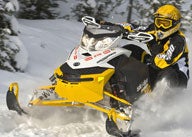
Steering wheel vs. motorcycle handlebars vs. cost
When steering a car to turn right or left, you, like a billion other people, rotate the steering wheel clockwise to navigate a right-handed turn or counterclockwise for a left-handed turn. Snowmobile handlebar posts that run over a motor (known as either laydown or horizontal), swing much like a steering wheel. Why? Because, the flatter the angle the more clocklike the rotation.
Ski-Doo and Yamaha have rallied around a business and production concept that allows commonality – parts shared across most, if not all, models. The Ski-Doo Summit and Yamaha Nytro MTX have over-the-motor steering posts; these posts are also shared with the mountain sled’s flat land buggies.
By sharing common parts across several platforms, production costs are reduced. This is good business sense. So, the TNT and Renegade share the same over-the-motor steering post as the Summit. Likewise, all Nytro platforms have the same. Furthermore, over-the-motor steering posts have far fewer parts than under-the-motor (vertical) steering posts; fewer parts equal less weight. Ski-Doo and Yamaha, filled with business-minded bean counters, look for every advantage to cut costs, which also plays into an engineer’s hand when looking to reduce weight.
We must be clear here, steering wheel-like swing (turning) benefits the snocross racer and fast trail burner. Sno Pros, MXZs, Nytros, Rush, IQs and SPs use this style of steering post. It works, it’s comfortable and it gives riders speed control for aggressive sit down riding.
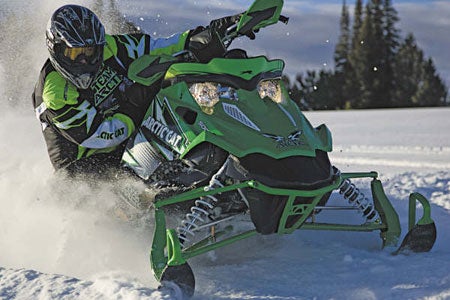 Arctic Cat’s Sno Pro 500, like Cat’s other Sno Pro race-inspired models, has a laydown (horizontal) steering post, which, as you can tell, allows the driver to lean and properly leverage the snowmobile’s handlebars for aggressive cornering – this keeps the snowmobile flat. This steering post concept is not shared with Cat’s M-series and Crossfire models.
Arctic Cat’s Sno Pro 500, like Cat’s other Sno Pro race-inspired models, has a laydown (horizontal) steering post, which, as you can tell, allows the driver to lean and properly leverage the snowmobile’s handlebars for aggressive cornering – this keeps the snowmobile flat. This steering post concept is not shared with Cat’s M-series and Crossfire models.So you drive a KTM or Honda CRF during the summer months. On these dirt toys, the handlebars swing, yes, clockwise and counterclockwise, but flat as compared to a car. The close ratio, nearly vertical steering mechanism is similar in function to Polaris’ RMK Dragon, Cat’s Ms and Yamaha’s Apex MTX. This behind-and-under-the-motor steering post is key to superb and easy sidehilling of those sleds. This steering post design gives drivers easy leverage to the chassis, while at the same the handlebars are properly positioned for sidehilling – when the driver is standing.
Bret Rasmussen, who works as an independent researcher/developer and performance consultant to the snowmobile aftermarket industry (his company – Snowmobile Research Services – SRS), has this to say, “Lay down, or horizontal steering posts are preferred for sit down style riding. I know because I rode an F6 for 2,000 miles in Alaska’s Iron Dog race last season. In a turn, the inside handlebar grip rotates down, thus allowing your body to be able to move forward and over the bar for more cornering control.
“With a vertical steering post (behind and under the motor) the inside grip will move into your body and prevent optimal body position [for sit down riding].
“Now let’s relate this to aggressive stand up mountain riding, Bret Rasmussen style. If I am on one running board and negotiating a technical side hill, or even a moderate side hill, when I pull on the outside handle bar grip to tip the sled up, it will easily go into a controlled counter steer. This is characteristic of a vertical post. If I do the same maneuver on a sled with a horizontal steering post, pulling on the outside grip will naturally turn the skis into the hill and prevent the sled from tipping up on one ski. Horizontal (laydown) posts keep both skis on the snow, thus greatly limiting the terrain that can be safely negotiated.”
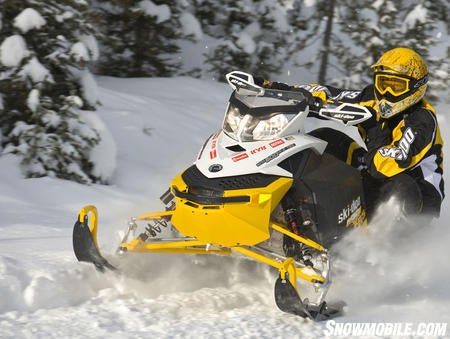 Ski-Doo’s MX Z X-RS is designed for optimum ditch banging and deep corner cutting. Its over-the-motor steering post is designed for driver and snowmobile stability – keeping the vehicle flat. Unlike Cat’s Sno Pro line, the MX Z X-RS steering post is shared with the XP Summit, though adapted for mountain use, the concept is the same.
Ski-Doo’s MX Z X-RS is designed for optimum ditch banging and deep corner cutting. Its over-the-motor steering post is designed for driver and snowmobile stability – keeping the vehicle flat. Unlike Cat’s Sno Pro line, the MX Z X-RS steering post is shared with the XP Summit, though adapted for mountain use, the concept is the same.The downfalls to the behind-and-under-the-motor steering post (vertical) is that its numerous components (up to 12 and more) are heavier than over-the-motor, resulting in higher production costs. These steering posts are specific to the RMK and M-series, and are not shared — mostly — with other platforms (except for the Ms and Crossfires; and the RMKs and Switchbacks).
Some may argue, and I am one, mountain sleds are unique and mountain riders want a steering post that allows for easy sidehilling. However, engineers, product managers and accountants may argue that the higher costs won’t please shareholders.
I see both sides.
When, and I believe the time will come, Cat and Polaris move to over-the-motor steering posts to reduce production costs and weight, then the Snowmobile.com Mountain Team implores: Do not sacrifice boondocking and sidehilling agility for a few pennies and ounces; unique works and unique is what a mountain sled is all about.
Sometimes, a penny saved is a dollar lost in sales.



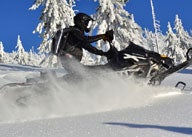
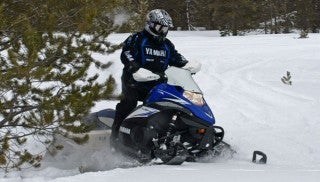
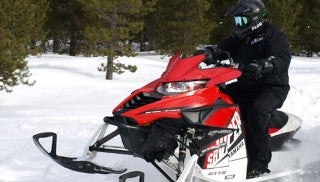


 Your Privacy Choices
Your Privacy Choices